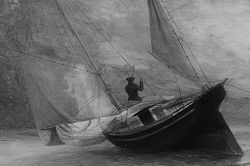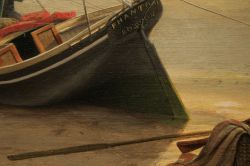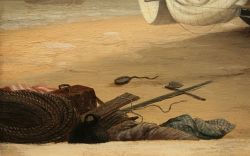loading 
Fitz Henry Lane
HISTORICAL ARCHIVE • CATALOGUE RAISONNÉ • EDUCATIONAL RESOURCE
An online project under the direction of the CAPE ANN MUSEUM
An online project under the direction of the CAPE ANN MUSEUM
Catalog entry
inv. 574
Phantom of Boston
c. 1850s Oil on panel 15 x 20 in. (38.1 x 50.8 cm) No inscription found
|





Commentary
(Note: for a fully illustrated version of this commentary, see the article New Discoveries: "Phantom of Boston" Donated to the Cape Ann Museum.)
This remarkable Lane discovery has been a long time in the works. The painting was acquired by Gustav Klimann in the late 1950s from an antiques dealer in Essex, the town immediately west of Gloucester. Mr. Klimann, who died in the 1970s, was a well-known art conservator and restorer in Boston who did work for numerous collectors, galleries and museums in New England from the 1930s through the 1960s. From the first moment he saw the painting, Mr. Klimann thought it was a Lane. He had seen many Lanes (and may have restored some) in the collection of his good friend Maxim Karolik, the pre-eminent collector of F.H. Lane and other nineteenth-century American artists. The Karolik collection had over a dozen Lanes and now forms the backbone of the Museum of Fine Arts Boston's American painting collection.
Mr. Klimann was a knowledgeable collector in his own right with a well-developed eye. The rediscovery of Lane was just starting in the 1940s and 50s after his many years of obscurity. In this era, many Lanes were being sold out of old New England houses in this era (particularly around Gloucester) for nominal prices. Like many of Lane's works, the painting is unsigned, as are many Lanes—the rarity of signed works likely contributed to Lane's long obscurity. The painting was donated to the Cape Ann Museum by Mr. Klimann'a wife Joan Klimann in 2014 in his memory.
The painting is medium-sized, 15 x 20 inches, on a panel of Magnolia wood, an unusual support. Interestingly, the town of Magnolia, which abuts Gloucester to the south, was named for a particularly large grove of native Magnolia trees, at the time thought to have been the northernmost extent of the species range.
The story the painting illustrates remains a mystery. The vessel is a private yacht that has run aground on a sandbar. The contents of the boat have been unloaded onto the beach; a fascinating collection of blankets, leather suitcases, a fish basket (identical to one in the Cape Ann Museum collection), a frying pan, jugs, pots, a kettle, a coil of rope, a hatchet and several rifles. The sail is half-hoisted to dry with the boom ingeniously supported by the boathook stuck into the sand. The smart red cushions lie on the deck to dry. The captain (and presumed owner), with his jaunty cap and tailored jacket, is anxiously looking towards a boat with five men being rowed towards him. The mate on the beach is looking down at a rifle in his hands as if to load it; another rifle is nearby. The sun is rising through a swirling mist.
Several scenarios have been suggested for this narrative. One is that the boat has gone aground and the approaching men in the boat are salvagers. The man on the beach is loading his rifle to keep them at bay while waiting for the tide to float the boat free. The boat's contents have been unloaded in an attempt to save them should the salvagers get the boat. Note the ominous cross made by the hatchet crossing a plank of wood in the lower left, a device Lane used in several paintings, including one of the Brace's Rock series.
A far more benign interpretation is based on marine historian Erik Ronnberg's identification of the vessel's design as British, and its similarity to boats used for duck hunting in the English salt marshes. While the transom clearly shows that the "Phantom" is from Boston, it was not uncommon to transport smaller boats to America from England or to have one built here to specifications. In this interpretation, the captain and crew have been caught overnight in a storm on their way to a duck hunt and have run aground on a sand bar near the salt marshes. Their belongings have been unloaded to dry and the rest of their hunting party is rowing in to help them off the bar—come high tide—and proceed with the duck hunt. Perhaps the boat owner commissioned the painting to memorialize the event.
Whichever the interpretation, this is a scene full of the anecdote and detail typical of so many Lane paintings. Stylistically, there are numerous Lane trademarks, beginning with the remarkable set of objects on both sides of the foreground. They are all skillfully painted and tonally coherent with attention to every detail, including the weave of the basket and the patterns on the blankets. The short-necked man with the gun, whose head and hat seem to grow directly from his shoulders, is another Lane trademark, seen particularly often in his early work. The rigging on the vessel is impeccably painted, a Lane talent that was unmatched by his peers. Note the boathook holding up the boom. This arrangement keeps the sails off the wet sand and also allows Lane to show the folds, drape and weight of the canvas—a subject that Lane treated in every variation throughout his career. The yacht is a beauty, the mahogany companionway doors setting off its painted interior and white masts. With its bright red cushions in place, it must have been a pleasure to sail.
The hull shows all its form and volume lying on its side on the beach. Lane painted an unusual number of works with boats aground, whether for repairs or otherwise. He clearly loved the sculptural forms of the hulls below their waterlines and understood every element of there construction. This is why his boats all sit or move through the water so convincingly: they show their weight and mass as they float, unlike the boats of so many other marine painters that sit a little high and seem detached from the gravity and resistance of the water.
The atmosphere is subtly rendered, with the sun breaking through the mist and casting alternating bands of shadow and light on the beach. The composition is defined by the diagonal of the masts, the angle of the hull, and the line of the rudder. The black triangle of the hull perfectly balances the corresponding white shape of the drying sails. The color scheme is a dramatic black, white and gold with Lane's usual enlivening spot of red.
Beyond stylistic evidence, the final test of Lane authorship is in the underdrawing technique, which can be seen using infrared photography. Based on numerous infrared scans of other Lane paintings, we know that Lane usually did detailed underdrawings in pencil on the canvas before painting. He drew the rigging in particular detail, as can be noted in the scans of numerous Lane ship portraits. In this case, he has drawn every line and stay in pencil, even the flourish of the halyard whipping around the mast in a corkscrew motion. One can also see the subtle adjustments that were made in the stern transom and interior coaming of the cockpit after the drawing.
Lane was not alone in doing underdrawings, but his are distinct from those artists most frequently confused with him. His student Mary Mellen did very little underdrawing, while the marine painter William Bradford, who emulated Lane in his early career, made multiple changes and erasures to his drawings. Lane's drawing shows very few adjustments—perhaps because of his training in lithography his drawing is unerringly accurate from the start.
Research is still ongoing for any record of the yacht or its owner. The painting is so specific in detail that it is hard not to imagine Lane being commissioned to paint the scene, possibly by the gentleman perched on the deck. Unfortunately, pleasure craft were not documented or taxed in that time, unlike commercial vessels, and there is no official record of yacht ownership that has been discovered. There were several large commercial vessels called “Phantom,” but nothing that could be confused with this boat. If Lane did do the painting on commission, there was likely to have been some kind of receipt; possibly even a letter between the owner and Lane describing the scene. As is so often the case with Lane, though, the paper record has disappeared or has yet to be found.
– Sam Holdsworth